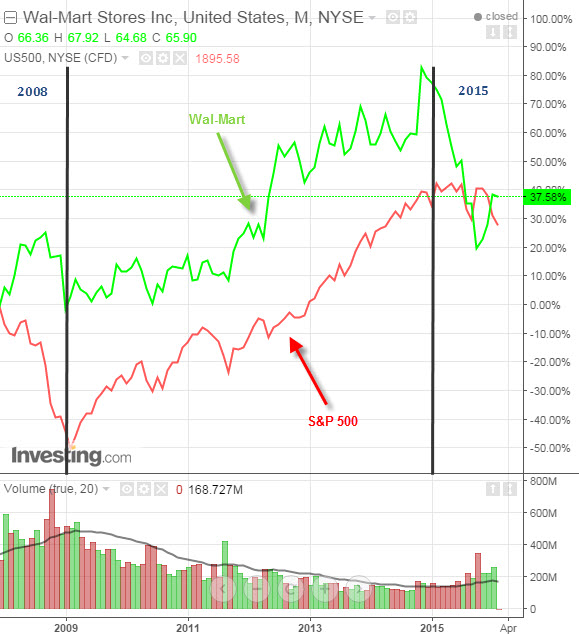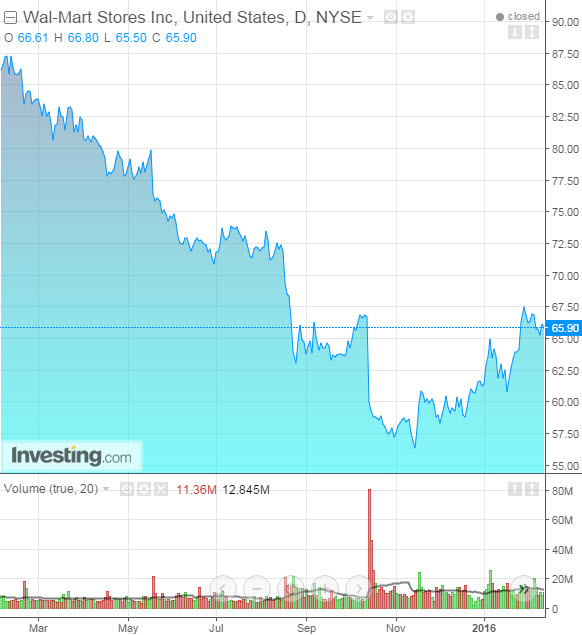By Clement Thibault
With nearly 11,600 stores worldwide, 5,000 of which are in the US, Wal-Mart (N:WMT) is the biggest bricks-and-mortar retailer in the world. It has also been one of the safest stocks to invest in over the past decade.
Remember the financial crisis at the end of 2008? It didn't effect Wal-Mart stock one bit. While the market was melting down, Wal-Mart's stock gained 17.95%; That's at the same time that the S&P 500 lost a terrifying 36.55%.

Although the S&P's growth over subsequent years was stronger, had an investor put $1,000 into both WMT and the SPX on January 1st 2008, they'd still be further ahead with their Wal-Mart shares. And that’s without taking into account Wal-Mart's growing dividend, which currently yields about 3%.
Unfortunately, since the beginning of 2015, Wal-Mart's status as an overachiever appears to be ancient history. While the S&P largely stagnated in 2015, the retailer's shares tumbled 28.62%—its biggest annual loss in decades.

WMT's miserable performance in 2015 was largely due to the big drop in the company's profitability. Twelve months trailing, Wal-Mart's EPS fell from 5.06 to 4.59—about 9 percent. At the same time, compared with last year, it recorded a drop in earnings over every single quarter. In and of itself, a 9% slip in profits might not warrant a 28% loss of value in its shares. However, one of Wal-Mart's problems is that it already operates on a very thin profit margin. Those 'Everyday Low Prices' don't come cheaply for the company.
Take Q3 '15 for example. Over that period, WMT reported $117.4B in revenue, $87.4B in COGS (cost of goods sold), and $24.2B in SGA (sales, general and administrative expenses), leaving the company with $5.7B of operating income. Subtract its $1.7B tax bill, and you're left with $3.4B of net income. Based on their Q3 earnings report, Wal-Mart's profit margin currently stands at a razor-thin 2.8%, while the industry's overall average net profit margin is considerably higher, at 4.23%. That's 46% more than Wal-Mart is making.
Another key issue the retailer currently faces is rising employment costs, as government mandated minimum wage hikes threaten to reduce the company's already slim profit margin. Wal-Mart employs some 1.4 million US-based staff, which amounts to hundreds of millions of man-hours needing to be paid each month. A one-dollar raise, per person, in labor costs could cut an additional $300 million quarterly from the bottom line, resulting in another 10% drop in profits.
If all that weren't enough, its biggest e-tail rival Amazon (O:AMZN) continues growing, as it remains unaffected by the many challenges that keep hitting bricks-and-mortar competitors, including Wal-Mart. Among Amazon's advantages: an almost nonexistent physical presence and a large army of robots at its disposal, which dramatically reduces the need for human labor (and human scale wages).
There was some talk last earnings season of WMT enhancing their online retail division, and at the end of 2015 the company launched "Walmart Pay", an app that allows customers to pay for merchandise via their smartphones. The company has also merged all its tech divisions into a new group it calls "Walmart Technology", whose mandate is to revolutionize Wal-Mart's digital retail efforts so they become more competitive versus Amazon.
Clearly, Wal-Mart is starting to recognize its problems. CEO Doug McMillon said in late 2015 that the company would review its operations and shut down underperforming stores. Indeed, on January 15th of this year, Wal-Mart announced the closure of 269 locations, kicking off a program to get itself back on track. The retailer's sheer size makes it harder for the company to stay flexible, but this is a good first step. Still, Wal-Mart is by no means shrinking; It plans to open more than 100 stores in the US this year, as well as an additional 200+ stores overseas.
All of this leaves Wal-Mart in a delicate position heading into Q4 '15 earnings and into 2016 in general. Its business is struggling, its profit margin is shrinking, but it is making the effort to stay relevant. So what might that mean for the company, and its stock after it reports?
Wal-Mart is like a mammoth dinosaur desperately trying to evolve before the ice age ends. Unfortunately, like the dinosaur, its massive size alone won't save it. At the end of the day—in business as in nature—it all comes down to the survival of the fittest. This doesn't mean we're seeing the end of the road for Wal-Mart just yet. But just like its fellow retailers—Macy's (N:M) and Best Buy (N:BBY), to name two—it has a lot of adapting to do.
WMT's 2014 Q4 report showed an EPS of 1.58, already down at that time from 1.60 in Q4 2013. This downtrend is set to continue, which should be more visible when Wal-Mart reports Q4 earnings before the bell on Thursday, February 18th. Forecasts call for 1.43 EPS and expected revenue of $131.6B.
